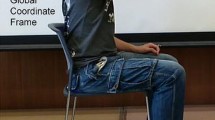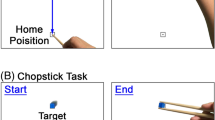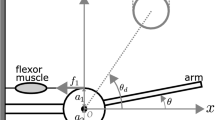Abstract
In this study, kinematic properties of human arm reaching movements have been analyzed by use of experimental results of arm trajectories observed in a three-dimensional (3D) space. In the beginning, hand paths obtained by the experiments are kinematically analyzed to pursue their linearity, and we successfully specify a plane on which a hand moves. In the next place, the hand speed profile is calculated by use of position data observed by the experiment in a 3D space. Besides, the hand speed profile is also analytically produced under the minimum jerk criterion with respect to the displacement along the hand path. These observed and produced trajectories are compared, and the similarity of two trajectories has been demonstrated. As a result of the analyses for path and the speed profile of a hand, kinematic properties of human arm trajectories have been identified.






Similar content being viewed by others
Explore related subjects
Discover the latest articles, news and stories from top researchers in related subjects.References
Flash T, Hogan N (1985) The coordination of arm movements: an experimentally confirmed mathematical model. J Neurosci 5:1688–1703
Alexander R (1997) A minimum energy cost hypothesis for human arm trajectories. Biol Cybern 76:97–105
Andel C, Wolterbeek N, Doorenbosch C et al (2008) Complete 3D kinematics of upper extremity functional tasks. Gait Posture 27(1):120–127
Amasay T, Karduna A (2009) Scapular kinematics in constrained and functional upper extremity movements. J Orthop Sports Phys Ther 39(8):618–627
Biryukova E, Roby-Brami A, Frolov A et al (2000) Kinematics of human arm reconstructed from spatial tracking system recordings. J Biomech 33(8):985–995
Kashima T, Sugawara K (2015) Experimental and theoretical analysis of human arm trajectories in 3D movements. Artif Life Robot 20:203–209
Author information
Authors and Affiliations
Corresponding author
About this article
Cite this article
Kashima, T., Sugawara, K. & Mitoh, A. Kinematic properties of human arm reaching movements in a three-dimensional space. Artif Life Robotics 23, 41–47 (2018). https://doi.org/10.1007/s10015-017-0395-9
Received:
Accepted:
Published:
Issue Date:
DOI: https://doi.org/10.1007/s10015-017-0395-9




